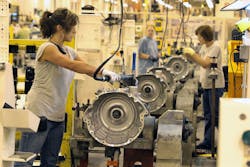As part of its announcement surrounding the launch of two new transmissions — an eight-speed rear-wheel drive and a nine-speed front-wheel drive — at its Kokomo, IN, plant, Chrysler has revealed that 3D software technologies are playing a key role in the upfront processes associated with the new transmissions.
"We knew we needed a new way of working to get our plants in Kokomo ready at an accelerated pace," says Brian Harlow, vice president and head of NAFTA Powertrain Operations and Global Powertrain Manufacturing Engineering at Chrysler. "By using 3D technology we are, in effect, injecting the principles of world-class manufacturing from the very beginning of our planning for production startups."
World-class manufacturing (WCM) is an integrated system that encompasses all plant processes. The goal of WCM is to continuously improve performance in order to reach the objective of zero waste, which includes zero accidents, zero breakdowns, zero waste of motion and zero inventories.
The 3D modeling system used by Chrysler’s powertrain manufacturing is Create3D from Strategic Manufacturing Solutions (Auburn Hills, MI). According to Harlow, the software is used to “help everyone see the shop floor as it really is and not how one might imagine it is.”
"We live in three dimensions, not two, so with a two-dimensional drawing, you had to imagine the third dimension," said Harlow. "Engineers have good imaginations, but those imaginations don't all work the same way. If you have 10 engineers looking at a 2D drawing, they will all see it a little differently."
Because 3D allows for images to be viewed from all angles, Harlow says that engineers can see the manufacturing environment, including equipment, materials and operators from a complete perspective. He contends that this wider view means that issues that may delay a program or cost money to fix can be addressed before the first piece of equipment arrives at the plant.
"Animation is another critical aspect of the 3D programming," says Harlow. "It allows us to validate cycle times and discover system-related issues even before the machinery is made. If there is a situation anywhere that compromises production, we can identify it up front in the process, something we ordinarily wouldn't know until the first day of production. Now we can be proactive. We can change cycle times by moving content or making changes with the machine tool builder."
One of the other benefits Harlow cites about the technology is the immediate information exchange between Chrysler plants around the world, machine tool builders and Strategic Manufacturing Solutions (SMS). Using a computerized white board, engineers at one plant can write directly on layouts, then that information goes back to SMS where the changes are integrated into a master layout. At any point in time, those layouts are available through a remote access system to anyone associated with the project.
Chrysler is not the only U.S. manufacturer leveraging such technology. Read about Ford’s use of virtual reality to reduce costs in its production operations.
About the Author
David Greenfield, editor in chief
Editor in Chief

Leaders relevant to this article:
